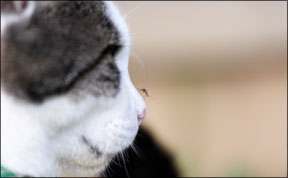The old-fashioned term “the cats whiskers” means the height of perfection or first-rate. Popular in the 1920s, this expression, along with “the cats meow,” referred to the daring flappers described as “impossible to shock.” While the term is American in origin, people have disagreed over who deserves 288 credit for coining it. Regardless, the phrases meaning shows that the people who first used the expressions certainly understood the unique capabilities of your felines most sensitive hairs. Cat whiskers – also called tactile hairs – are found on your cats eyebrows, chin, cheeks and in an area behind its forelegs above the paw. They are two to three times thicker than other hairs and taper to a fine, flexible tip. Approximately 12 of these stiff bristles align in four rows that protrude from either side of the cats muzzle. The top row moves independently of the middle row. “Whiskers are connected to sensory receptors that relay messages directly to the central nervous system, and are an extension of the cats tactile devices,” says Paul DeMars, DVM, of Oklahoma State University, Oklahoma. They sport longer roots than your cats other hairs and are embedded three times deeper into kittys body in dermal sacs. At the other end of each whisker is a sensory organ – called a mechanoreceptor – that sends a message to your cat in response to stimuli. A cats whiskers grow in proportion to its body. Environmental Navigation. “During the day, a cat does not have as much need to use its whiskers. Most are located in the front of the animal, around the eyes and near the nose. They enhance the senses when vision is diminished,” explains Dr. DeMars, who is board-certified by the American Board of Veterinary Practitioners. When your cat flexes its whiskers back and forth throughout the day, the mechanoreceptors detect subtle changes in air currents or vibrations and translate these into messages that indicate prey movement or the location of objects like trees and furniture. Facial whiskers are well-developed on most predatory species to enhance hunting abilities, and their location determines their function. The ones located on the muzzle or “whisker pad” augment navigation skills in restricted spaces or in darkness. These whiskers extend approximately the width of the cats body. Although legend purports that cats use their whiskers to decide whether an opening is large enough for their bodies to pass through, this has never been scientifically proven. It is certain, though, that facial whiskers help determine the bite point on a preys neck. Whiskers located on the forelegs collect information about captured prey. Because cats are farsighted, they often cannot see animals in their clutches. The leg whiskers allow cats to estimate size, shape and position of their prey, as well as their own position relative to it. These whiskers also help detect escape attempts. Used for Communication. Similar to people – who smile and frown to show emotion – cats use their prominent facial whiskers position and amount of spread to communicate three distinct moods. In experiments, whiskerless cats repeatedly missed their prey when springing for it. Forcing whiskers into a position counter to their natural alignment causes discomfort and may trigger a swat from a cat with claws fully arrayed. As with other types of hair, whiskers are shed periodically, but not to worry: A healthy replacement will grow in.
Your Cats Whiskers
She can use them to hunt, to navigate her environment and even to convey her moods. Heres how they work.
Shy or afraid. Closely bunched whiskers lying flat against a cats cheeks make its face appear smaller and less threatening. This look can also mean your cat is angry or feels vulnerable. This position is typical of cats that are feeding or are greeting another cat.
Tense or excited. Your cat needs to sense all outside stimuli when hunting, playing or walking, so its whiskers will be bristling, fully fanned and bending almost straight forward. When the long whiskers are positioned this way, the shorter facial whiskers will bend forward as well to allow your cat to assess prey positions.
Content or calm. The whiskers will be pushed neither forward nor back, but resting somewhere in between since your cat has no reason to sense its environment.



